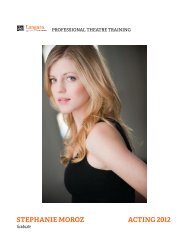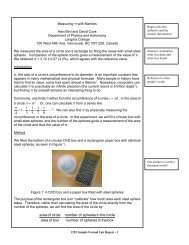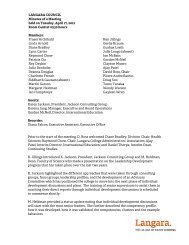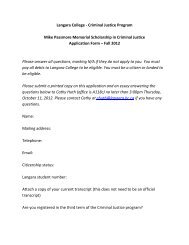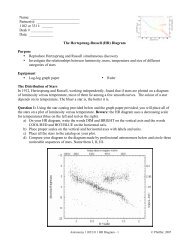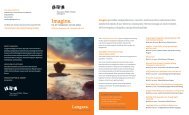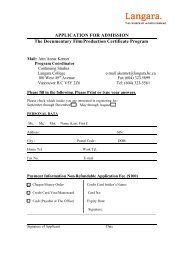Langara College 2009 Current Student Survey Report
Langara College 2009 Current Student Survey Report
Langara College 2009 Current Student Survey Report
You also want an ePaper? Increase the reach of your titles
YUMPU automatically turns print PDFs into web optimized ePapers that Google loves.
<strong>Langara</strong> <strong>College</strong><br />
<strong>2009</strong> <strong>Current</strong> <strong>Student</strong> <strong>Survey</strong> <strong>Report</strong><br />
Office of Institutional Research<br />
<strong>Langara</strong> <strong>College</strong><br />
May 3, 2010
TABLE OF CONTENTS<br />
LANGARA COLLEGE CURRENT STUDENT SURVEY – FALL <strong>2009</strong><br />
SURVEY SAMPLE AND METHODOLOGY ................................................................... 1<br />
Table 1: Characteristics of <strong>Student</strong> Population and <strong>Survey</strong> Respondents ............................................... 1<br />
PROFILE OF LANGARA STUDENTS ............................................................................ 2<br />
Table 2: Demographic Profile of <strong>Survey</strong> Respondents............................................................................. 2<br />
Table 3: Registration Program of Respondents ....................................................................................... 2<br />
Figure 1: Hours per Week Spent Working and Studying .......................................................................... 3<br />
Figure 2: Primary Mode of Transportation ................................................................................................ 3<br />
REASONS FOR CHOOSING LANGARA ....................................................................... 4<br />
Figure 3: Reasons for Attending <strong>Langara</strong> ................................................................................................. 4<br />
FIRST IMPRESSIONS OF LANGARA ........................................................................... 5<br />
Figure 4: Satisfaction with <strong>Langara</strong> Experience ....................................................................................... 5<br />
Figure 5: If You Could Start Over Again, Would You Attend <strong>Langara</strong>?.................................................... 5<br />
Figure 6: Initial Impressions of <strong>Langara</strong> <strong>College</strong> ...................................................................................... 5<br />
SKILL DEVELOPMENT .................................................................................................. 6<br />
Figure 7: Skill Development Ratings ........................................................................................................ 6<br />
INSTRUCTION ................................................................................................................ 7<br />
Figure 8: Evaluation of Course Instruction ............................................................................................... 7<br />
PROGRAM/COURSE OF STUDY .................................................................................. 8<br />
Figure 9: Evaluation of Program/Course of Study .................................................................................... 8<br />
PROGRAM QUALIFICATION ........................................................................................ 9<br />
Figure 10: Upgrading Required to Qualify for Program Entrance ............................................................ 9<br />
CAMPUS LIFE ................................................................................................................ 9<br />
Figure 11: Areas of Campus Life Emphasized by <strong>Langara</strong> <strong>College</strong> ......................................................... 9<br />
LANGARA STUDENT SERVICES ............................................................................... 10<br />
Figure 12: General Ratings of <strong>Langara</strong> <strong>College</strong> Services ...................................................................... 10<br />
LANGARA APPLICATION PROCESS ......................................................................... 11<br />
Figure 13: Importance of Prior Contact in Decision to Apply to <strong>Langara</strong> ............................................... 11<br />
Figure 14: Application Method of New <strong>Langara</strong> <strong>Student</strong>s ...................................................................... 11<br />
Figure 15: Clarity of Program Admission Requirements ........................................................................ 12<br />
Figure 16: The <strong>Langara</strong> Application Process ......................................................................................... 12<br />
LANGARA REGISTRATION PROCESS ...................................................................... 13<br />
Figure 17: Methods of Finding Fall <strong>2009</strong> Registration Date ................................................................... 13<br />
Figure 18: Registration Guide and Course Schedule Preferences ........................................................ 13<br />
Figure 19: The <strong>Langara</strong> Registration Process ........................................................................................ 14<br />
Figure 20: <strong>Student</strong> Ratings of Registrar's Office .................................................................................... 15<br />
LANGARA COURSE REGISTRATION ........................................................................ 16<br />
Figure 21: Number of <strong>Student</strong>s Not Able to Register in Desired Courses ............................................. 16<br />
Figure 22: Why Arts & Sciences <strong>Student</strong>s Could Not Register in Desired Courses .............................. 16<br />
Figure 23: Influential Factors in <strong>Student</strong>s’ Course Selection .................................................................. 16<br />
Figure 24: <strong>Student</strong> Course Scheduling Preferences .............................................................................. 17<br />
GENERAL COMMENTS ............................................................................................... 17
LANGARA COLLEGE CURRENT STUDENT SURVEY – FALL <strong>2009</strong><br />
SURVEY SAMPLE AND METHODOLOGY<br />
This year saw major changes in the structure and methodology of the <strong>Current</strong> <strong>Student</strong> <strong>Survey</strong>. Instead<br />
of one very long survey, we released three separate surveys to three randomly selected samples. The<br />
core questions were the same in all three surveys, but each also had a section devoted to a specific<br />
student service. The first two surveys focused on the <strong>Langara</strong> application and registration processes. The<br />
final survey asked students about course scheduling experiences and preferences. The Application<br />
survey was sent out to a randomly selected sample of 1,500 new students. The Registration and Courses<br />
surveys were each emailed to random samples of 1,400 new and returning students. The samples closely<br />
reflected the actual student population on program area and gender. Email notifications for the online<br />
questionnaires were sent out on October 29, with reminders on November 2, 6 and 12. By the survey<br />
deadline, a total of 1,178 valid questionnaires were returned, a final response rate of 27.4%. The<br />
accuracy of the survey results is estimated to be ±2.9%, 19 times out of 20.<br />
A comparison of the survey respondents to the student population showed that this response sample<br />
over-represented female students, and slightly over-represented international students, students with<br />
higher GPAs and those attending full time. Because of the oversampling of new students for the<br />
Application survey, the overall response sample strongly over-represented new students. Each set of<br />
survey respondents was compared to its original population, and responses were weighted to achieve a<br />
sample representative of the student population. The set of core questions were merged and weighted<br />
against the whole student population.<br />
Limited Enrollment students comprised such a small portion of the response sample that they were<br />
grouped with Arts and Sciences for reporting purposes.<br />
Table 1: Characteristics of <strong>Student</strong> Population and <strong>Survey</strong> Respondents<br />
Characteristics<br />
<strong>Student</strong><br />
Population<br />
Respondents<br />
(unadjusted)<br />
Respondents<br />
(adjusted)<br />
Gender Male 44.2% 37.6% 44.2%<br />
Female 55.8% 62.4% 55.8%<br />
Major Program Area Arts & Science 74.9% 75.2% 74.9%<br />
Limited Enrolment 1.5% 1.9% 1.5%<br />
Career 10.6% 11.9% 10.6%<br />
Degree 13.0% 11.0% 13.0%<br />
Registration Status New 32.9% 57.7% 56.4%<br />
Returning 67.1% 42.3% 43.6%<br />
Course Load Full-time 72.3% 80.4% 72.3%<br />
Part-time(
PROFILE OF LANGARA STUDENTS<br />
LANGARA COLLEGE CURRENT STUDENT SURVEY – FALL <strong>2009</strong><br />
Table 2: Demographic Profile of <strong>Survey</strong> Respondents<br />
Characteristics Percent Characteristics Percent<br />
Gender Male 44.2% Course Load Full-time 79.1%<br />
Age 1<br />
Female 55.8% Part-time 20.9%<br />
17 or younger 20.3% Registration Status New 1 56.4%<br />
18-21 years 44.9% Returning 1<br />
43.6%<br />
22-25 years 16.7% Domestic 88.7%<br />
26-30 years 8.4% International 11.3%<br />
31-39 years 6.4% Aboriginal 1.5%<br />
40+ 3.3%<br />
First Language English 74.9% Terms at <strong>Langara</strong> 1-3 Terms 70.5%<br />
French 1.0% 4-6 Terms 14.8%<br />
Mandarin 9.7% 7-9 terms 9.3%<br />
Cantonese 5.9% 10-12 Terms 2.8%<br />
Korean 2.0% 13+ Terms 2.5%<br />
Japanese 1.0%<br />
Filipino/Tagalog 0.8%<br />
Farsi/Persian 0.7%<br />
Other 4.0%<br />
Table 3: Registration Program of Respondents<br />
PROGRAM % PROGRAM %<br />
Arts and Sciences 74.9% Display + Design 0.4%<br />
Aboriginal Studies 0.3% Early Childhood Education 0.8%<br />
European Studies 0.1% Education Assistant 0.1%<br />
Bachelor of Business Administration 7.1% Engineering Transfer 0.1%<br />
Business Management 0.1% Fine Arts 1.5%<br />
Marketing Management 0.1% Journalism 1.0%<br />
Bachelor of Science in Nursing 3.3% Library & Information Technology 1.8%<br />
Nursing Transition/Waitlist 2.6% Nutrition & Food Service Management 0.6%<br />
Bachelor of Recreation Management 0.3% Professional Photo Imaging 0.4%<br />
Applied Urban & Rural Planning 0.5% Publishing 0.7%<br />
Criminal Justice 1.3% Recreation 0.9%<br />
Commerce 0.1% Social Service Worker 0.3%<br />
Computer Studies 0.2% Theatre Arts 0.1%<br />
Management Information Systems 0.1%<br />
1<br />
These variables are not representative of the actual population, since this survey oversampled new students in<br />
order to better examine the Application process.<br />
Office of Institutional Research pg. 2
LANGARA COLLEGE CURRENT STUDENT SURVEY – FALL <strong>2009</strong><br />
In general, students spent more time studying or preparing for class than working, although part-time<br />
work remained prevalent. <strong>Student</strong>s over age 26 were most likely to be working more than 31 hours per<br />
week, while younger students tended to work part-time or not at all.<br />
1%<br />
38%<br />
Figure 1: Hours per Week Spent Working and Studying<br />
36%<br />
18%<br />
33%<br />
22%<br />
Public transit was the most popular mode of transportation by far, especially among younger students.<br />
Use of public transit has increased by almost 11 percentage points since Fall 2008.<br />
Figure 2: Primary Mode of Transportation<br />
Office of Institutional Research pg. 3<br />
19%<br />
13%<br />
None 1-10 hrs/wk 11-20 hrs/wk 21-30 hrs/wk 31-40 hrs/wk >40 hrs/wk<br />
1%<br />
18%<br />
2%<br />
6%<br />
1%<br />
Time spent preparing for class<br />
Time spent working for pay<br />
9%<br />
72%<br />
7%<br />
3%<br />
Walk<br />
Bicycle<br />
3%<br />
Automobile<br />
Public Transit<br />
Carpool<br />
Other
LANGARA COLLEGE CURRENT STUDENT SURVEY – FALL <strong>2009</strong><br />
REASONS FOR CHOOSING LANGARA<br />
<strong>Student</strong>s decided to come to <strong>Langara</strong> for a variety of reasons. Foremost were <strong>Langara</strong>’s reputation as<br />
a transfer institution, our program or course offerings, class size and tuition rates. Comparison to previous<br />
years is not justifiable, as the number of factors presented in the survey was expanded greatly this year.<br />
Arts and Sciences students were influenced primarily by <strong>Langara</strong>’s reputation as a transfer institution,<br />
but also by class size and tuition rates. Both class size and tuition were much more important for young<br />
students. For Career/Vocational students, <strong>Langara</strong>’s program/course offerings were the most influencing<br />
factor, followed by program reputation then class size. Program reputation was significantly more<br />
influential to students in Photography, Fine Arts, Marketing Management, Journalism, Early Childhood<br />
Education, Education Assistant, Recreation and Social Services Worker programs. Degree students were<br />
also most motivated by <strong>Langara</strong>’s program/course offerings (more so for Nursing than Business<br />
students), but tuition rates and distance from home were also important.<br />
<strong>Langara</strong>'s reputation as a transfer<br />
institution<br />
Offers the program/course(s) I want<br />
Figure 3: Reasons for Attending <strong>Langara</strong><br />
<strong>Langara</strong> class size<br />
The tuition rates suit me<br />
Close to where I live<br />
<strong>Langara</strong> programs have good reputations<br />
<strong>Langara</strong> is easy to get to<br />
Friend's/parent's recommendation<br />
I wasn't accepted at my first choice<br />
The availability of online options<br />
The availability of evening options<br />
Other<br />
0% 10% 20% 30% 40% 50% 60% 70% 80%<br />
Note: Percentages do not total 100% as respondents were asked to select their top three reasons.<br />
Arts & Sciences<br />
Career/Vocational<br />
Degree<br />
Office of Institutional Research pg. 4
LANGARA COLLEGE CURRENT STUDENT SURVEY – FALL <strong>2009</strong><br />
FIRST IMPRESSIONS OF LANGARA<br />
Seventy percent of respondents were ‘somewhat’ or ‘very’ satisfied with their overall experience at<br />
<strong>Langara</strong>. Career/Vocational students were most likely to be very satisfied. However, the most influential<br />
factor in overall satisfaction was not program, but age: <strong>Student</strong>s over age 29 were significantly more likely<br />
to be ‘very satisfied’. Among students age 29 and under, cumulative GPA was the best predictor of<br />
satisfaction, with high achievers and new students somewhat more likely to be ‘very satisfied’.<br />
Arts & Sciences<br />
Figure 4: Satisfaction with <strong>Langara</strong> Experience<br />
Very Satisfied<br />
Career<br />
Somewhat Satisfied<br />
Degree<br />
Neutral<br />
Somewhat Dissatisfied<br />
0% 20% 40% 60% 80% 100%<br />
Very Dissatisfied<br />
The great majority (87.5%) of students would ‘probably’ or ‘definitely’ attend <strong>Langara</strong> again, given the<br />
chance to start over. Again, Career/Vocational student ratings were the most positive. <strong>Student</strong>s with<br />
cumulative GPA greater than 3.3 were more likely to say they would ‘definitely’ attend.<br />
Arts & Sciences<br />
Career<br />
Degree<br />
Figure 5: If You Could Start Over Again, Would You Attend <strong>Langara</strong>?<br />
0% 20% 40% 60% 80% 100%<br />
Approximately two thirds of students had positive initial impressions of <strong>Langara</strong>. Overall quality of<br />
services received the most encouraging reviews. However, availability of information and overall quality of<br />
service received significantly lower ratings from students who had attended <strong>Langara</strong> for more than three<br />
terms. Older students tended to rate higher on helpfulness and friendliness of <strong>Langara</strong> staff.<br />
Arts &<br />
Sciences<br />
Career/<br />
Vocational<br />
Degree<br />
Figure 6: Initial Impressions of <strong>Langara</strong> <strong>College</strong><br />
Friendliness<br />
Helpfulness<br />
Availability of information you need<br />
Organization<br />
Overall quality of service<br />
Friendliness<br />
Helpfulness<br />
Availability of information you need<br />
Organization<br />
Overall quality of service<br />
Friendliness<br />
Helpfulness<br />
Availability of information you need<br />
Organization<br />
Overall quality of service<br />
Definitely yes<br />
Probably yes<br />
Probably not<br />
Definitely not<br />
0% 20% 40% 60% 80% 100%<br />
Very Good Good Adequate Poor Very Poor<br />
Office of Institutional Research pg. 5
LANGARA COLLEGE CURRENT STUDENT SURVEY – FALL <strong>2009</strong><br />
SKILL DEVELOPMENT<br />
This section focused on the extent to which students’ programs had prepared them in developing<br />
specific abilities. Arts and Sciences students rated critical thinking and independent learning skills most<br />
positively. Degree students felt they had well developed skills in teamwork and critical thinking.<br />
Career/Vocational students thought they were best prepared in independent learning and reading skills,<br />
and were much more likely to feel very well prepared in all skill areas.<br />
Aside from program area differences, other influencing factors were age and cumulative GPA.<br />
Reading skills were rated significantly lower by 17-18 year old students. Older students felt better<br />
prepared in problem solving and speaking skills. New students and students with a cumulative GPA<br />
greater than 2.6 felt significantly more prepared to learn independently and speak effectively.<br />
Ratings have generally remained stable since 2008. This year saw minor improvements in ratings of<br />
writing skills from Career/Vocational and Arts and Sciences students and critical thinking skills from<br />
Degree students. Degree and Career/Vocational students’ ratings of Math skills decreased slightly.<br />
Arts & Sciences<br />
Career/ Vocational<br />
Degree<br />
Critical Thinking/Analysis<br />
Independent Learning<br />
Reading & Comprehension<br />
Problem Resolution<br />
Teamwork<br />
Written Communication<br />
Oral Communication<br />
Math Skills<br />
Critical Thinking/Analysis<br />
Independent Learning<br />
Reading & Comprehension<br />
Problem Resolution<br />
Teamwork<br />
Written Communication<br />
Oral Communication<br />
Math Skills<br />
Critical Thinking/Analysis<br />
Independent Learning<br />
Reading & Comprehension<br />
Problem Resolution<br />
Teamwork<br />
Written Communication<br />
Oral Communication<br />
Math Skills<br />
Figure 7: Skill Development Ratings<br />
0% 20% 40% 60% 80% 100%<br />
Very Well Well Adequately Poorly Very Poorly<br />
Office of Institutional Research pg. 6
LANGARA COLLEGE CURRENT STUDENT SURVEY – FALL <strong>2009</strong><br />
INSTRUCTION<br />
Ratings of course instruction at <strong>Langara</strong> were quite positive. Arts and Sciences and Career/Vocational<br />
students gave their best ratings to instructor knowledge, while Degree students were most positive about<br />
their ability to ask questions in class. Career/Vocational student ratings were higher than Arts and<br />
Sciences or Degree students’ in almost all areas. Ratings have remained relatively stable since 2008.<br />
Program area was only a significant factor in ratings of instructor knowledge of topics, where Career<br />
student ratings were much higher. In general, older students provided better ratings of course content,<br />
clarity of assignments and fair grading systems. <strong>Student</strong>s with cumulative GPA greater than 2.6 were<br />
much more likely to strongly agree that assignments contributed to their understanding of the topic and<br />
that they had opportunities to ask questions in class.<br />
Arts & Sciences<br />
Career/ Vocational<br />
Degree<br />
Figure 8: Evaluation of Course Instruction<br />
I have opportunities to ask questions in class<br />
Instructors are knowledgeable about course topics<br />
Course content is current<br />
Assignments contribute to understanding of subjects<br />
Assignments are clearly outlined & defined<br />
Instructors effectively communicate course material<br />
Course grading system is fair<br />
I have opportunities to ask questions in class<br />
Instructors are knowledgeable about course topics<br />
Course content is current<br />
Assignments contribute to understanding of subjects<br />
Assignments are clearly outlined & defined<br />
Instructors effectively communicate course material<br />
Course grading system is fair<br />
I have opportunities to ask questions in class<br />
Instructors are knowledgeable about course topics<br />
Course content is current<br />
Assignments contribute to understanding of subjects<br />
Assignments are clearly outlined & defined<br />
Instructors effectively communicate course material<br />
Course grading system is fair<br />
0% 20% 40% 60% 80% 100%<br />
Strongly Agree Agree Neutral Disagree Strongly Disagree<br />
Office of Institutional Research pg. 7
LANGARA COLLEGE CURRENT STUDENT SURVEY – FALL <strong>2009</strong><br />
PROGRAM/COURSE OF STUDY<br />
When asked to provide opinions on various other aspects of their <strong>Langara</strong> programs, positive ratings<br />
were highest for overall quality of instruction, regardless of area of study. Arts & Sciences students also<br />
rated program organization quite well, while Career/Vocational and Degree students were very happy with<br />
the amount of practical experience they received. Program or career counselling received the least<br />
positive evaluation from students in all areas of study. Compared to 2008, positive ratings remained<br />
stable or increased in almost all areas. There were notable improvements in program organization and<br />
equipment other than computers.<br />
Program area was the most influential factor in ratings of overall quality of instruction, program<br />
organization, amount of practical experience and computer equipment. New students were significantly<br />
more likely to give program or career counselling ‘good’ ratings, while full-time returning students most<br />
often rated this service as ‘adequate’.<br />
Arts & Sciences<br />
Career/ Vocational<br />
Degree<br />
Quality of instruction<br />
Organization of Program<br />
Computer hardware & software<br />
Textbooks & learning materials<br />
Amount of practical experience<br />
Equipment other than computers<br />
Program or career counselling<br />
Quality of instruction<br />
Organization of Program<br />
Computer hardware & software<br />
Textbooks & learning materials<br />
Amount of practical experience<br />
Equipment other than computers<br />
Program or career counselling<br />
Quality of instruction<br />
Organization of Program<br />
Computer hardware & software<br />
Textbooks & learning materials<br />
Amount of practical experience<br />
Equipment other than computers<br />
Program or career counselling<br />
Figure 9: Evaluation of Program/Course of Study<br />
0% 10% 20% 30% 40% 50% 60% 70% 80% 90% 100%<br />
Very Good Good Adequate Poor Very Poor<br />
Office of Institutional Research pg. 8
PROGRAM QUALIFICATION<br />
LANGARA COLLEGE CURRENT STUDENT SURVEY – FALL <strong>2009</strong><br />
For the first time, we asked students about the level of upgrading they needed to qualify for their<br />
program. Just over half of students entered their program with no upgrading. Improved English and Math<br />
skills were common prerequisites, particularly among Arts and Sciences students. Approximately 13% of<br />
students needed English as a second language before they qualified for their program. Career/Vocational<br />
students were least likely to need upgrading, while Arts and Sciences students were most likely.<br />
Arts &<br />
Sciences<br />
Career/<br />
Vocational<br />
Degree<br />
CAMPUS LIFE<br />
Figure 10: Upgrading Required to Qualify for Program Entrance<br />
Upgraded Math to qualify<br />
Upgraded Sciences to qualify<br />
Upgraded English to qualify<br />
Upgraded English as a second language<br />
Upgraded Math to qualify<br />
Upgraded Sciences to qualify<br />
Upgraded English to qualify<br />
Upgraded English as a second language<br />
Upgraded Math to qualify<br />
Upgraded Sciences to qualify<br />
Upgraded English to qualify<br />
Upgraded English as a second language<br />
0% 5% 10% 15% 20% 25% 30%<br />
Overall, ratings of <strong>Langara</strong>’s focus on campus life i increased from last year, especially among Degree<br />
students. <strong>Student</strong>s over age 29 were more likely to say that <strong>Langara</strong> focused ‘quite a bit’ on studying and<br />
academic work. New students and those with higher cumulative GPAs felt <strong>Langara</strong> provided better<br />
academic support. Domestic students (and particularly returning domestic students) were most likely to<br />
feel that <strong>Langara</strong> provided ‘some’ or ‘very little’ focus on campus social life and non-academic support.<br />
Arts &<br />
Sciences<br />
Career/<br />
Vocational<br />
Degree<br />
Figure 11: Areas of Campus Life Emphasized by <strong>Langara</strong> <strong>College</strong><br />
Studying and academic work<br />
Academic support<br />
Non-academic support<br />
Campus social-life<br />
Studying and academic work<br />
Academic support<br />
Non-academic support<br />
Campus social-life<br />
Studying and academic work<br />
Academic support<br />
Non-academic support<br />
Campus social-life<br />
0% 10% 20% 30% 40% 50% 60% 70% 80% 90% 100%<br />
Very Much Quite a Bit Some Very Little<br />
Office of Institutional Research pg. 9
LANGARA COLLEGE CURRENT STUDENT SURVEY – FALL <strong>2009</strong><br />
LANGARA STUDENT SERVICES<br />
Among the general student population, almost all <strong>Langara</strong> services received more than 50% positive<br />
ratings. Top ratings went to the <strong>Langara</strong> Library (80% ‘good’ or ‘very good’), computer labs (70%) and<br />
safety on campus (68%). Negative ratings (‘very poor’ or ‘poor’) given to the Cafeteria (31%), athletic<br />
activities and Counselling (17% each) were somewhat higher than for other <strong>College</strong> services.<br />
Library<br />
Computer Labs<br />
Safety on Campus<br />
Web Registration<br />
my<strong>Langara</strong><br />
Campus Security<br />
<strong>Langara</strong> Website<br />
Application for Admission<br />
<strong>Student</strong> Accounts<br />
Registrar's Office<br />
Web calendar<br />
Health Services<br />
Study space<br />
Paper calendar<br />
Classrooms<br />
Information Kiosk<br />
Automated Waitlist<br />
Counselling<br />
Co-op Education<br />
Campus Signs/Directories<br />
Financial Aid Office<br />
Cafeteria<br />
Disability Services*<br />
Services for Aboriginal <strong>Student</strong>s*<br />
Daycare*<br />
Athletic Activities*<br />
Figure 12: General Ratings of <strong>Langara</strong> <strong>College</strong> Services<br />
* These services were rated as ‘Have Not Used’ by at least 66% of respondents.<br />
0% 20% 40% 60% 80% 100%<br />
Very Good Good Adequate Poor Very Poor<br />
Degree students gave significantly lower ratings to classroom space than did Career/Vocational or<br />
Arts and Sciences students. <strong>Langara</strong>’s calendars (both web and paper) were rated higher by part-time<br />
students. <strong>Student</strong>s with cumulative GPAs greater than 2.4 were much more positive about application;<br />
web registration and the automated waitlist. The cafeteria and campus signage received significantly<br />
better ratings from students aged 17 and under. New students were more positive than returning students<br />
about the Registrar’s Office, campus security and study space.<br />
Office of Institutional Research pg. 10
LANGARA COLLEGE CURRENT STUDENT SURVEY – FALL <strong>2009</strong><br />
When compared to 2008, Arts and Sciences and Career/Vocational student ratings of almost all<br />
<strong>Langara</strong> services remained stable or decreased, but in most cases the declines were much greater<br />
among Career/Vocational students. Career/Vocational ratings of Co-op Education, Health Services, the<br />
Financial Aid Office and the Daycare all dropped by more than 26 percentage points, and six other<br />
services declined by more than 10 percentage points. For both Arts and Sciences and Career/Vocational<br />
students, the one exception to this trend was my<strong>Langara</strong>, where positive ratings increased by 6 to 16<br />
percentage points. Degree student ratings were the most positive, remaining stable or increasing in most<br />
service areas. Athletics, the Financial Aid Office and my<strong>Langara</strong> received positive rating increases of<br />
more than 18 percentage points. The only areas where Degree students gave declining rating were the<br />
Information Kiosk, Campus signage and Counselling.<br />
The overall trend for the last five years has been one of declining ratings for most services. The<br />
exception was in Fall 2008, when almost all services received at least some increase in positive ratings.<br />
LANGARA APPLICATION PROCESS<br />
This year’s survey contained a section devoted to examining students’ experience with <strong>Langara</strong>’s<br />
application process. This segment was given to new students only.<br />
Prior to applying to <strong>Langara</strong>, 50% of new students visited the campus on their own, and 71% of those<br />
felt it was ‘very’ or ‘somewhat’ important to their decision to apply to <strong>Langara</strong>. Male students were slightly<br />
more likely to visit <strong>Langara</strong> on their own, but female students were significantly more likely to believe that<br />
their visit was influential in their decision to come here. Fewer students (33%) came for a <strong>Langara</strong><br />
Information Session, but those that did reported more influence on their decision. Female students were<br />
significantly more likely to find the Information sessions ‘very important’.<br />
Figure 13: Importance of Prior Contact in Decision to Apply to <strong>Langara</strong> 2<br />
I visited <strong>Langara</strong> on my own (n=196)<br />
I came to a <strong>Langara</strong> Info. Session (n=128)<br />
A <strong>Langara</strong> rep. came to my school (n=91)<br />
A <strong>Langara</strong> employee contacted me (n=29)<br />
0% 20% 40% 60% 80% 100%<br />
Very Important Somewhat Important<br />
Somewhat Unimportant Very Unimportant<br />
Just over two thirds of all new students (and 83% of new students age 17 or younger) applied online.<br />
Among students over age 17, those taking full-time studies also preferred online applications, while those<br />
studying part-time were divided between applying online and in-person.<br />
Arts & Sciences<br />
Career/Vocational<br />
Figure 14: Application Method of New <strong>Langara</strong> <strong>Student</strong>s<br />
Degree<br />
0% 10% 20% 30% 40% 50% 60% 70% 80%<br />
2 ‘n’ specifies how many students had this type of contact before applying to <strong>Langara</strong>.<br />
Online<br />
In person<br />
By mail<br />
Office of Institutional Research pg. 11
LANGARA COLLEGE CURRENT STUDENT SURVEY – FALL <strong>2009</strong><br />
Very few students had difficulty understanding their Program admission requirements. Career/<br />
Vocational students were the least likely to have difficulties in this area.<br />
Arts & Sciences<br />
Career/Vocational<br />
Figure 15: Clarity of Program Admission Requirements<br />
Degree<br />
0% 10% 20% 30% 40% 50% 60% 70% 80% 90% 100%<br />
Very Somewhat Not very Not at all<br />
Even though new Degree students found it easier to reach application staff, all new students were<br />
fairly happy with how helpful staff were in answering their application questions. New Arts and Sciences<br />
and Career/Vocational students were more positive than Degree students about receiving a timely<br />
response to their application. Fewer students, and particularly Career/Vocational students, felt that the<br />
<strong>Langara</strong> website contained all the information they needed to apply.<br />
Arts & Sciences<br />
Career/<br />
Vocational<br />
Degree<br />
Figure 16: The <strong>Langara</strong> Application Process<br />
Timely response to application<br />
Helpful in answering application questions<br />
Easy to reach application staff<br />
Website had all info. needed to apply<br />
Timely response to application<br />
Helpful in answering application questions<br />
Easy to reach application staff<br />
Website had all info. needed to apply<br />
Timely response to application<br />
Helpful in answering application questions<br />
Easy to reach application staff<br />
Website had all info. needed to apply<br />
0% 20% 40% 60% 80% 100%<br />
Strongly Agree Agree Neutral Disagree Strongly Disagree<br />
<strong>Student</strong>s were asked to provide open-ended comments regarding any problems they experienced and<br />
improvements they would most like to see. The most common complaints and suggestions were about<br />
the clarity or availability of information and instructions, particularly regarding the online application<br />
process. Verbatim comments are available on request.<br />
Office of Institutional Research pg. 12
LANGARA COLLEGE CURRENT STUDENT SURVEY – FALL <strong>2009</strong><br />
LANGARA REGISTRATION PROCESS<br />
<strong>Student</strong>s were also asked about their experience with the <strong>Langara</strong> registration process. This segment<br />
was given to both new and returning students. Regardless of program area, the majority of students found<br />
their registration date through the <strong>Langara</strong> website. However, students who had attended <strong>Langara</strong> for<br />
only one or two terms were significantly less likely to use the website, and more likely to receive this<br />
information via an email to their personal address. Thirty percent of new students got their registration<br />
date from their registration letter.<br />
Arts & Sciences<br />
Career<br />
Degree<br />
Figure 17: Methods of Finding Fall <strong>2009</strong> Registration Date<br />
Registration letter<br />
Email to my<strong>Langara</strong> address<br />
Email to personal address<br />
<strong>Langara</strong> website<br />
<strong>Langara</strong> HelpLine<br />
Registration letter<br />
Email to my<strong>Langara</strong> address<br />
Email to personal address<br />
<strong>Langara</strong> website<br />
<strong>Langara</strong> HelpLine<br />
Registration letter<br />
Email to my<strong>Langara</strong> address<br />
Email to personal address<br />
<strong>Langara</strong> website<br />
<strong>Langara</strong> HelpLine<br />
0% 10% 20% 30% 40% 50% 60% 70%<br />
<strong>Student</strong>s overwhelmingly preferred the online registration guide and course schedule to the paper<br />
versions, although approximately one quarter of Degree and Arts and Sciences students still use paper.<br />
<strong>Student</strong>s who have taken more than two terms at <strong>Langara</strong> were significantly more likely than newer<br />
students to use the paper course schedule.<br />
100%<br />
80%<br />
60%<br />
40%<br />
20%<br />
0%<br />
Figure 18: Registration Guide and Course Schedule Preferences<br />
Arts &<br />
Sciences<br />
Career Degree Arts &<br />
Sciences<br />
Career Degree<br />
Registration Guide Course Schedule<br />
Web Paper<br />
Office of Institutional Research pg. 13
LANGARA COLLEGE CURRENT STUDENT SURVEY – FALL <strong>2009</strong><br />
Among <strong>Langara</strong>’s registration services, the most positive ratings were given to “The my<strong>Langara</strong><br />
registration website is easy to navigate”, “The online Registration Guide is helpful” and “Registration<br />
instructions were easy to follow” (72% each). Personal service areas such as “It was easy to reach<br />
someone who could answer my registration questions” received less positive responses. Returning<br />
students were more positive than new students about the paper registration guide and the ease of<br />
registration instructions. <strong>Student</strong>s over age 22 were more likely to think that the online registration guide<br />
was helpful. Female students found registration instructions easier to locate. <strong>Student</strong>s who had attended<br />
more than 6 terms at <strong>Langara</strong> found the waitlist instructions easier to follow and were more likely to feel<br />
that the website provided all necessary information. Second year students had the hardest time reaching<br />
someone to answer their registration questions.<br />
Arts & Sciences<br />
Career<br />
Degree<br />
Figure 19: The <strong>Langara</strong> Registration Process<br />
my<strong>Langara</strong> registration site is easy to navigate<br />
Paper Registration Guide is helpful<br />
Online Registration Guide is helpful<br />
Registration instructions were easy to find<br />
Registration instructions were easy to follow<br />
Waitlist instructions were easy to find<br />
Waitlist instructions were easy to follow<br />
Easy to reach someone to answer reg. questions<br />
<strong>Langara</strong> was helpful answering reg. questions<br />
The website provided all the info. needed to register<br />
my<strong>Langara</strong> registration site is easy to navigate<br />
Paper Registration Guide is helpful<br />
Online Registration Guide is helpful<br />
Registration instructions were easy to find<br />
Registration instructions were easy to follow<br />
Waitlist instructions were easy to find<br />
Waitlist instructions were easy to follow<br />
Easy to reach someone to answer reg. questions<br />
<strong>Langara</strong> was helpful answering reg. questions<br />
The website provided all the info. needed to register<br />
my<strong>Langara</strong> registration site is easy to navigate<br />
Paper Registration Guide is helpful<br />
Online Registration Guide is helpful<br />
Registration instructions were easy to find<br />
Registration instructions were easy to follow<br />
Waitlist instructions were easy to find<br />
Waitlist instructions were easy to follow<br />
Easy to reach someone to answer reg. questions<br />
<strong>Langara</strong> was helpful answering reg. questions<br />
The website provided all the info. needed to register<br />
0% 20% 40% 60% 80% 100%<br />
Strongly Agree Agree Neutral Disagree Strongly Disagree<br />
Office of Institutional Research pg. 14
LANGARA COLLEGE CURRENT STUDENT SURVEY – FALL <strong>2009</strong><br />
Registrar’s Office products received relatively positive ratings, with the ‘Course Search’ function on the<br />
registration website being the most used and best rated service, followed closely by the Web Registration<br />
Guide. The <strong>Langara</strong> Helpline and ‘Contact Us’ email were the least used services. The two Registrar’s<br />
Office phone lines were the most poorly rated services. There was little difference between program<br />
areas when rating Registrar's Office products, but Career/Vocational students were the most positive<br />
about the Registrar’s Office staff. Newer students were less liable to use the paper registration guide and<br />
more likely to use the “Contact Us” email service. New and second year students gave less positive<br />
ratings of the web registration guide.<br />
Arts & Sciences<br />
Career<br />
Degree<br />
Figure 20: <strong>Student</strong> Ratings of Registrar's Office<br />
Paper Registration Guide (n=124)<br />
Web Registration Guide (n=238)<br />
Web registration "Course Search" (n=241)<br />
Registrar's front counter staff (n=138)<br />
Other Registrar's staff (n=63)<br />
<strong>Langara</strong> HelpLine (323-5595) (n=51)<br />
Registrar's main line (323-5241) (n=64)<br />
"Contact Us" email (n=61)<br />
Paper Registration Guide (n=10)<br />
Web Registration Guide (n=30)<br />
Web registration "Course Search" (n=30)<br />
Registrar's front counter staff (n=15)<br />
Other Registrar's staff (n=7)<br />
<strong>Langara</strong> HelpLine (323-5595) (n=8)<br />
Registrar's main line (323-5241) (n=11)<br />
"Contact Us" email (n=11)<br />
Paper Registration Guide (n=21)<br />
Web Registration Guide (n=40)<br />
Web registration "Course Search" (n=35)<br />
Registrar's front counter staff (n=20)<br />
Other Registrar's staff (n=9)<br />
<strong>Langara</strong> HelpLine (323-5595) (n=4)<br />
Registrar's main line (323-5241) (n=9)<br />
"Contact Us" email (n=2)<br />
0% 10% 20% 30% 40% 50% 60% 70% 80% 90%100%<br />
Very Good Good Adequate Poor Very Poor<br />
Note: ‘n’ specifies the number of students who indicated that they had used the service this semester.<br />
Office of Institutional Research pg. 15
LANGARA COLLEGE CURRENT STUDENT SURVEY – FALL <strong>2009</strong><br />
LANGARA COURSE REGISTRATION<br />
For the most part, Career/Vocational and Degree students were able to register in all the courses they<br />
wanted this Fall term. In Arts and Sciences, only 54% of new and 63% of returning students got all the<br />
courses they wanted.<br />
Figure 21: Number of <strong>Student</strong>s Not Able to Register in Desired Courses<br />
Arts & Sciences<br />
Career/Vocational<br />
Degree<br />
0 20 40 60 80 100 120 140 160 180 200 220 240 260 280 300<br />
Full courses were the largest complaint, followed by courses not fitting the students’ schedule. Arts<br />
and Sciences students (particularly those who were new or had a cumulative GPA of 2.17 or below) had<br />
significantly more difficulty with full courses. <strong>Student</strong>s with a CGPA of 2.17 or less were more likely to<br />
have scheduling difficulties, regardless of program area.<br />
Figure 22: Why Arts & Sciences <strong>Student</strong>s Could Not Register in Desired Courses<br />
Course(s) I wanted were not offered at all<br />
Course(s) I wanted were not offered in the evening<br />
Course(s) I wanted were not offered at a good time<br />
Course(s) I wanted were offered but full<br />
Scheduling conflict w/ course lecture component<br />
Scheduling conflict w/ course lab/studio component<br />
Of the 430 students who were not able to enroll in all their desired classes, 24% missed at least one<br />
course because every section was full, while 20% had scheduling conflicts that resulted in at least one<br />
missed class. Eighty-five students enrolled in one or more courses mainly because there were seats<br />
available. Sixty-five students (mostly returning Arts and Sciences students) also took courses at other<br />
institutions this term, most often at SFU or UBC.<br />
The most influential factor in students’ course selection was that the course was required (83%). This<br />
was particularly the case for full-time Career/Vocational and Degree students. Young students were the<br />
most likely to be persuaded by a course description or title. Male students were more likely to be<br />
influenced by conversations with faculty or other students.<br />
Figure 23: Influential Factors in <strong>Student</strong>s’ Course Selection<br />
Course required for program or credential<br />
Course description<br />
I like the instructor<br />
Conversation with other students<br />
Course title<br />
Conversation with Counselling<br />
Conversation with faculty<br />
New Returning<br />
New Returning<br />
0 20 40 60 80 100 120 140 160 180 200<br />
Number of <strong>Student</strong>s<br />
0% 10% 20% 30% 40% 50% 60% 70% 80% 90%<br />
Office of Institutional Research pg. 16
LANGARA COLLEGE CURRENT STUDENT SURVEY – FALL <strong>2009</strong><br />
When asked about course scheduling, students were overwhelmingly in favour of two 2-hour daytime<br />
classes. After the 2x2 blocks, Arts and Sciences students preferred weekday four 1-hour blocks.<br />
Career/Vocational and Degree students’ second choice was Summer term daytime classes. Saturday<br />
daytime classes were everyone’s least favourite option.<br />
The most influential factors with regards to scheduling were the students’ age and course load.<br />
Significantly more full-time students thought that the 2x2 block was ‘very convenient’. Part-time students<br />
liked the 3-hour blocks on Friday more than full-time students, and were much more apt to find the four 1hour<br />
blocks ‘impossible’. <strong>Student</strong>s age 19 and younger were significantly more likely to find weekday<br />
evening classes ‘inconvenient’, Saturday 3-hour blocks ‘impossible’ and Summer evening classes either<br />
‘inconvenient’ or ‘impossible’. These two schedules were mainly practical for a small number of part-time<br />
students over age 19. Weekday evening classes were ‘very convenient’ for students over age 24.<br />
Arts & Sciences<br />
Career/Vocational<br />
Degree<br />
Figure 24: <strong>Student</strong> Course Scheduling Preferences<br />
Weekdays during the day, two 2-hour blocks<br />
Weekdays during the day, four 1-hour blocks<br />
Weekday evenings<br />
Friday during the day, one 3-hour block<br />
Saturday during the day, one 3-hour block<br />
Summer daytime<br />
Summer evenings<br />
Weekdays during the day, two 2-hour blocks<br />
Weekdays during the day, four 1-hour blocks<br />
Weekday evenings<br />
Friday during the day, one 3-hour block<br />
Saturday during the day, one 3-hour block<br />
Summer daytime<br />
Summer evenings<br />
Weekdays during the day, two 2-hour blocks<br />
Weekdays during the day, four 1-hour blocks<br />
Weekday evenings<br />
Friday during the day, one 3-hour block<br />
Saturday during the day, one 3-hour block<br />
Summer daytime<br />
Summer evenings<br />
0% 10% 20% 30% 40% 50% 60% 70% 80% 90%100%<br />
Very Convenient Somewhat Convenient Inconvenient Impossible<br />
GENERAL COMMENTS<br />
The most common comments provided were about the cafeteria, instructors, sports and social<br />
activities and <strong>Langara</strong> Campus. Cafeteria comments were overwhelmingly negative, and mostly focused<br />
on the prices and lack of healthy food. <strong>Student</strong>s gave a variety of suggestions, praise and critiques<br />
regarding instruction. Quite a few students called for more the opportunity for athletic and social activity. A<br />
lot of students like the new buildings but complain about classroom temperatures and the shortage of<br />
quiet study space. They generally approve of the Library, but some commented that that it is too loud for<br />
studying. Verbatim comments are available on request.<br />
i Question taken with permission from the <strong>Student</strong> and Information Technology in Higher Education 2007<br />
Questionnaire, EDUCAUSE Center for Applied Research.<br />
Office of Institutional Research pg. 17





